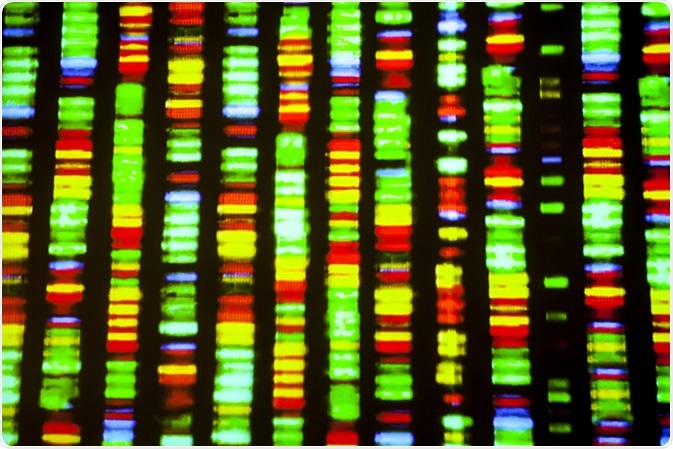
Future DNA Sequencing Techniques
DNA sequencing has undergone radical advances since the first Sanger sequencing method was introduced in 1977. Sanger sequencing made use of randomly added chain-terminating deoxynucleotides during DNA synthesis to generate DNA chains of lengths differing by one base pair. Those were then separated on a polyacrylamide gel and “read” left to right like a book. Today, there is a wide array of improved methods with rapid and precise results.

DNA sequence. Image Credit: Gio.tto / Shutterstock
From Sanger Method to Single Molecule Sequencing
In the late 1990s and 2000s, the Human Genome Project drove improvements on the aforementioned Sanger method that included whole genome shotgun sequencing and next-generation sequencing methods. By breaking up large sequences of DNA and sequencing them simultaneously in a massively parallel fashion, data could be generated faster. With improving computer technology, the sequence could then be reassembled and whole genomes began to be decoded.
Companies like Solexa and Life Technologies improved on those methods yet again, creating next generation sequencing technologies. In next generation sequencing, DNA template fragments are attached to solid surfaces like glass slides or microbeads for more automated, high throughput handling. Some chemical innovations have been added in second generation sequencing. These methods were developed and gained popularity in the 2000s.
Even newer methods are now on the horizon. Single molecule sequencing (SMS) is an approach that bypasses amplification by PCR, a crucial step in all next generation technologies. PCR amplification multiplies the original template DNA fragment by hundreds or thousands of times so that it can be visualized by optical detection methods.
SMS methods interrogate a single DNA molecule, overcoming problems and biases introduced by the PCR process. The potential advantages of SMS over next-generation sequencing include faster turnaround time, longer read lengths, higher accuracy, less starting material, and lower cost. It is estimated that with SMS, a whole genome might be sequenced for as little as $100.
Helicos Genetic Analysis
The Helicos Genetic Analysis Platform sequences individual DNA molecules bonded to a flat surface as they are extended. Fluorescently labeled nucleotide analogs, called Virtual Terminator nucleotides. This technology still requires a pause after each round of extension to read the sequence, but it eliminates the PCR step required for next-generation technologies like Illumina and Roche 454.
The raw error rates on sequencing an individual DNA strand are more than 5 percent. However, when sequencing is carried out in a highly parallel manner, the consensus finished sequence accuracy is over 99 percent. This method can also be used to sequence RNA directly, by substituting reverse transcriptase for DNA polymerase. Helicos Genetic Analysis was used to sequence the genome of one of its co-founders, Dr. Stephen Quake, for under $50,000 in 2009. However, Helicos subsequently filed for Chapter 11 bankruptcy in 2012.
Single Molecule Real Time Sequencing
Pacific Biosciences developed the Single Molecule Real Time (SMRT) Sequencing method, which is based on directly observing synthesis of a single strand of DNA. SMRT sequencing makes use of a nanometer-scale chamber to isolate a single DNA strand and DNA polymerase. The DNA polymerase molecule is anchored and then flooded with fluorescently labeled nucleotides.
The nucleotides can be detected as they diffuse down to the bound DNA strand and are recognized and incorporated by DNA polymerase. The diffusion and extension process happens in milliseconds, which means that DNA polymerase is added several bases per second. Because the fluorescent dye is attached to the nucleotide through a phosphate chain, it disconnects from the nucleotide during the DNA polymerase reaction, freeing itself from the growing DNA chain.
An important advantage of SMS technologies is that they sequence the molecule continuously, rather than pausing to read after each round of base extension. Also, the method has the propensity to generate longer sequence reads when compared to other platforms on the market today.
Reviewed by: Dr Tomislav Meštrović, MD, PhD
Sources
Further Reading
Last Updated: Sep 11, 2017























.png)











No hay comentarios:
Publicar un comentario